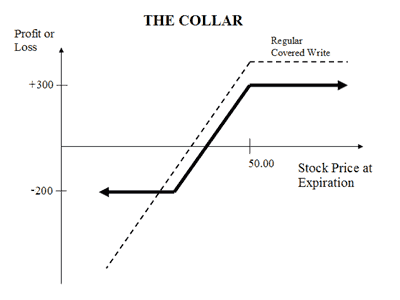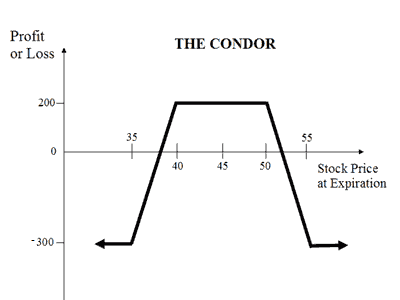 Zerodha (Trading Account)
Zerodha (Trading Account)
FREE Equity Delivery and MF
Flat ₹20/trade Intra-day/F&O
 Zerodha (Trading Account)
Zerodha (Trading Account)
FREE Equity Delivery and MF
Flat ₹20/trade Intra-day/F&O

|
|
Compare Collar and Long Condor (Long Call Condor) options trading strategies. Find similarities and differences between Collar and Long Condor (Long Call Condor) strategies. Find the best options trading strategy for your trading needs.
| Collar | Long Condor (Long Call Condor) | |
|---|---|---|
 |
 |
|
| About Strategy | A Collar is similar to Covered Call but involves another position of buying a Put Option to cover the fall in the price of the underlying. It involves buying an ATM Put Option & selling an OTM Call Option of the underlying asset. It is a low risk strategy since the Put Option minimizes the downside risk. However, the rewards are also limited and is perfect for conservatively Bullish market view. Suppose you are holding shares of SBI currently trading at Rs 250. You can deploy a collar strategy by selling a Call Option of strike price Rs 300 while at the same time purchasing a Rs 200 strike price Put option. If the price rises to Rs 300, your benefit from increase in value of your holdings and you will lose net premiums. If the price falls... Read More | A Long Call Condor is a neutral market view strategy with a limited risk and a limited profit. The long call condor investor is looking for little or no movement in the underlying. It is a 4 leg strategy which involves buying 2 ITM Calls and 2 OTM Calls at different strike price with the same expiry date. The strategy is similar as long butterfly strategy with the difference being in the strike prices selected. Suppose Nifty is currently trading at 10,400. The long call condor strategy can be used if expect very little volatility in the index and market to largely remain range bound. To profit in such a market scenario lets: Long Call Condor Options Strategy OrdersExample NIFTY Strike Price Buy 1 ITM CallNIFTY18APR10200C... Read More |
| Market View | Bullish | Neutral |
| Strategy Level | Advance | Advance |
| Options Type | Call + Put + Underlying | Call |
| Number of Positions | 3 | 4 |
| Risk Profile | Limited | Limited |
| Reward Profile | Limited | Limited |
| Breakeven Point | Price of Features - Call Premium + Put Premium | |
| Collar | Long Condor (Long Call Condor) | |
|---|---|---|
| When to use? | The Collar strategy is perfect if you're Bullish for the underlying you're holding but are concerned with risk and want to protect your losses. |
The Long Call Condor works well when you expect the price of the underlying to be range bound in the coming days. In other words, when the trader is anticipating minimal price movement in the underlying during the lifetime of the options. |
| Market View | Bullish When you are of the view that the price of the underlying will move up but also want to protect the downside. |
Neutral When you are unsure about the direction in the movement in the price of the underlying but are expecting little volatility in it in the near future. |
| Action |
|
Suppose Nifty is currently trading at 10,400. You expect little volatility in the index and market to largely remain range bound. To profit in such a market scenario, you can buy buy 1 ITM Nifty Call Option at 10,200, sells 1 ITM Nifty Call Option 10,300, sell 1 OTM Call Option at 10,500 and buy 1 OTM Nifty Call Option at 10,800. The Net debit of premium is the maximum possible loss while your maximum profit will be when Nifty is between the strike prices of 2 short calls on expiry. |
| Breakeven Point | Price of Features - Call Premium + Put Premium |
There are 2 break even points in this strategy. The upper break even is hit when the underlying price is equal to the difference between higher strike price and net premium paid. The lower break even is hit when the underlying price is equal to the total of lower strike price and net premium paid. Lower Breakeven = Lower Strike Price + Net Premium Upper breakeven = Higher Strike Price - Net Premium |
| Collar | Long Condor (Long Call Condor) | |
|---|---|---|
| Risks | Limited You will incur maximum losses when price of the underlying is less than the strike price of the Put Option. Max Loss = Purchase Price of Underlying - Strike Price of Long Put - Net Premium Received |
Limited The maximum risk in a long call condor strategy is equal to the net premium paid at the time of entering the trade. The max risk is when the price of the underlying equal to or below the lower strike price or when the underlying price is equal to or above the higher strike price of Options in trade at expiration time. |
| Rewards | Limited You will incur maximum profit when price of underlying is greater than the strike price of call option. Max Profit = Strike Price of Short Call - Purchase Price of Underlying + Net Premium Received |
Limited The maximum profit in a long call condor strategy is realized when the price of the underlying is trading between the two middle strikes at time of expiration. |
| Maximum Profit Scenario | Underlying goes up and Call option exercised |
Both ITM Calls exercised Max Profit = Strike Price of Lower Strike Short Call - Strike Price of Lower Strike Long Call - Net Premium Paid |
| Maximum Loss Scenario | Underlying goes down and Put option exercised |
All Options exercised or not exercised Max Loss = Net Premium Paid |
| Collar | Long Condor (Long Call Condor) | |
|---|---|---|
| Advantages | It protects the losses on underlying asset. |
It allows you to profit from range bound underlying at low capital. The profit is high with limited risk exposure. The maximum profit for the condor trade may be low in relation to other trading strategies but it has a comparatively wider profit zone. |
| Disadvantage | The profit is limited |
Strike prices selected may have an impact on the potential of profit. Brokerage and taxes makes a significant impact on the profits from this strategy. The cost of trading increases with number of legs. This strategy has 4 legs and thus the brokerage cost is higher. |
| Simillar Strategies | Covered Put Bull, Call Spread, Bull Put Spread | Long Put Butterfly, Short Call Condor, Short Strangle |

Add a public comment...

FREE Intraday Trading (Eq, F&O)
Flat ₹20 Per Trade in F&O
|
|